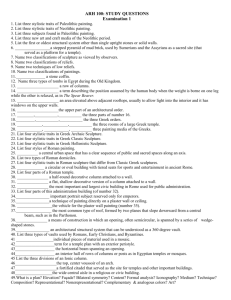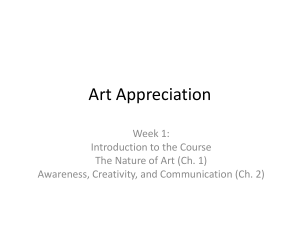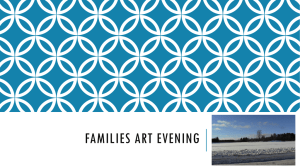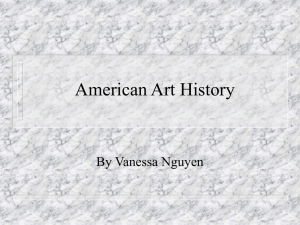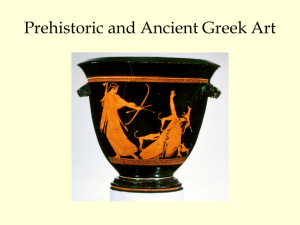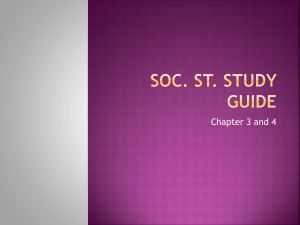Paleolithic
advertisement
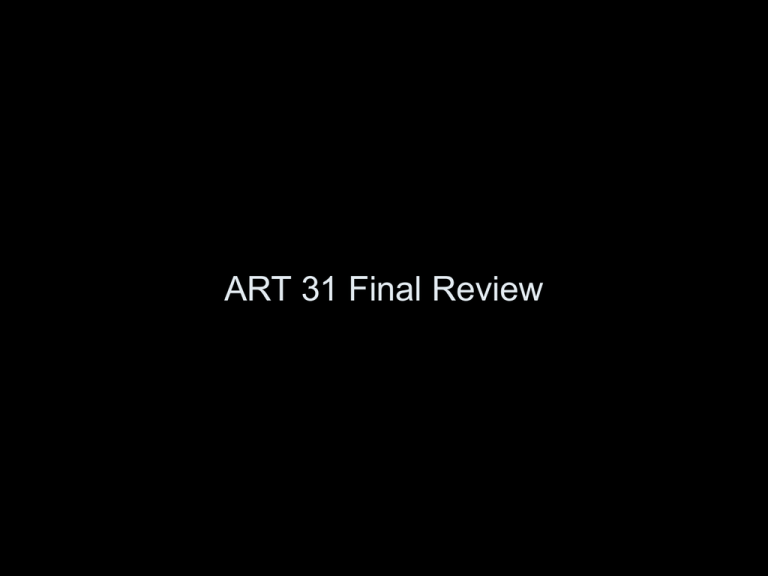
ART 31 Final Review Paleolithic: “Venus” of Willendorf Paleolithic: “Venus” of Laussel “The Neolithic Revolution” The Shift from Paleolithic to Neolithic Paleolithic (Old Stone Age) Neolithic (New Stone Age) Nomadic Hunter-Gatherers Cave Dwellings and Shrines Portable sculpture Cave Paintings Settled in Permanent Villages Domesticated Agriculture & Animal Husbandry Megalithic Architecture “Birth of Civilization” Neolithic: Stonehenge Salisbury Plain, England the beginning of Post and Lintel Architecture Characteristics of Near Eastern Art •Use of hierarchical proportion/scale to depict leaders or gods larger than everyone else •Use of cuneiform •Stylized Major themes: Rulers, Military Conquest, Gods and Religious Practices, Animals Cuneiform Hierarchical Scale Victory Stele of Naram-Sin Akkadian Characteristics of Egyptian Art •Use of canon of proportions •Static and un-changing •Combined frontal and profile views •Use of hieroglyphics •Stylized •Gender color differentiation: (male/red : female/yellow) Major themes: Unification, Divine Kingship, Gods and Religious Practices, and Rebirth Menkaure and Queen Old Kingdom, Dynasty 4 Egyptian Canon of Proportion The Pyramids of Giza Old Kingdom, Dynasty 4 (tombs of the Pharaohs Menkaure, Khafre and Khufu) Characteristics of Greek Art •Idealized forms •Contrapposto pose •Emphasis on balance and proportion •Marble and bronze sculpture Major themes: Gods and Goddesses, Religious Events, Funerary Practices, Mythology Greek Pottery Painting Black Figure Painting Red Figure Painting Early Classical: Kritios Boy Marble, c.480 B.C.E. Contrapposto: The “s-curve” used in Classical Greek sculptures showing the body standing at rest, with one leg bearing the weight while the hips and shoulders are asymmetrical. Perfected by the Greek sculptor Polykleitus. The Classical Orders of Architecture: Doric Ionic Corinthian 3 major parts of column: base, shaft, and capital Classical Greek Architecture: Iktinos and Kallikrates [Architects] The Parthenon, Athens, c.447-438 B.C.E. Post and Lintel Architecture. Doric. Dedicated to the goddess Athena. Decorated with sculpture showing battles between Greeks and barbarians, and the Panathenaic Festival Plan of the Parthenon Gray Block represents the location of the original Athena Parthenos statue. Characteristics of Hellenistic Greek Sculpture •Exploration of youth and old age •Theatricality and Melodrama •Extremes of Emotion •Formal Realism Laocoön and Sons Materials and Techniques: Terra-cotta: an orange colored earthenware (clay) material used for pottery and sculpture. Buon or True Fresco: a technique of painting of the plaster surface of a wall or ceiling. In buon fresco the paint is applied while the plaster is still damp, so that the pigments bond with the wall. Mosaic: the use of small pieces of glass, stone, or tile (tesserae) to create an image on a wall, floor, or ceiling. Innovations of Roman Architecture Techniques: Types of Structures: coffer oculus concrete dome vault true arch aqueduct amphitheater triumphal arch basilica rotunda forum Roman Architecture: The Colosseum Roman Architecture: The Pantheon Roman Architecture: The Arch of Titus In 313 C.E. the Roman Emperor Constantine issued the Edict of Milan, a document granting tolerance of all religions. This effectively legalized Christianity. chi rho Characteristics of Early Christian Art and Byzantine Art •Stylized individuals •Mosaic decoration •Incorrect human proportions •The illusion of weightlessness or floating •Religious themes •Illuminated Manuscripts made of vellum (calfskin) Major components of a basilica or early church apse: a projecting part of the building, usually a half-dome, often on the East end. Nave: the long, narrow, central area used to house the congregation. apse nave Gothic Architecture: Created by Abbot Suger . First used in his re-design of the French Royal Monastery, St. Denis. Characteristic Elements: •Pointed Arches •Stained Glass •Rose windows •Clerestory •Lancet windows •Triforium •Piers •Flying Buttresses Tympanum: the hemispheric section above the portals (doorways) in Romanesque or Gothic cathedrals Flying Buttresses Rose Window Characteristics of the Renaissance •Artists began to think of themselves as artists as well as craftsmen •Religious art was combined with the visual conventions of the Greek and Roman traditions •Art was interpreted according to the philosophy known as “Humanism” Giotto The Betrayal of Christ (The Kiss of Judas) 1305-06, Arena Chapel, Padua Masaccio (Tommaso Guidi), Holy Trinity, fresco, 1425 Donatello, David, bronze c.1430-40 Italian Artists Working During the High Renaissance •Leonardo da Vinci e.g. The Mona Lisa, The Last Supper • Michelangelo e.g. The Sistine Chapel Ceiling, The Sistine Chapel Last Judgment, David, Pieta • Raphael e.g. The School of Athens Illusions of Depth: linear perspective: a method of creating the illusion of 3dimensional space on a 2-dimensional surface by delineating a horizon line and multiple “orthogonal” lines. These lines recede into the supposed distance and meet at one or more points on the horizon, called “vanishing points.” foreshortening: a method of perspective used to represent a single object extending back into space at an angle to the picture plane Leonardo da Vinci, The Last Supper, c.1495-98 Leonardo da Vinci Mona Lisa , c.1503-05 Sfumato was favored by da Vinci. sfumato: a technique of applying many thin layers of paint to create a “smoky” effect. Raphael, The School of Athens, 1509-11,Vatican, Rome Portraits of Renaissance artists as Greek philosophers, Mathematicians, and scientists. Michelangelo David, 1501-04 Galleria dell’Accademia, Florence Michelangelo Last Judgment, 1534-41 Sistine Chapel, Rome Titian (Tiziano Vecelli, 1490-1576) The Venus of Urbino, c.1538 Northern Renaissance or Netherlandish Painting •Characterized by highly symbolic religious or genre (daily life) scenes. •Major artists were Jan van Eyck, Robert Campin, Albrecht Durer Diptych (two panels), triptych (three panels), and polyptychs (many panels): paintings on hinged panels of wood, typically altarpieces for churches. Jan van Eyck The Arnolfini Wedding Portrait, oil on wood,1434 Characteristics of Mannerism •Bright colors •Elongated bodies •Lack of linear perspective •Complex human poses •Unusual combinations of elements Agnolo Bronzino, Allegory of Venus (Venus, Cupid, Folly and Time), c.1546 Leading Baroque Artists •from Italy: Caravaggio, Gentileschi •from Holland: Rembrandt, Vermeer, Rubens •from Spain: Diego Velazquez Peter Paul Rubens (Flemish, 1577-1640) The Raising of the Cross, 1609 chiaroscuro / tenebrism: Strong, dramatic use of light and dark in contrast, to focus on an important element or to build of volume. Vermeer, The Geographer, 1668, oil on canvas Neoclassicism: A late 18th to early 19th Century style of art characterized by a return to the rational arts of the Classical world. Coincided with the French Revolution. Jacques-Louis David, Oath of the Horatii Romanticism: A late 18th to early 19th Century style of art characterized by heightened emotions, dramatic scale and impact, and spiritualism. Romantic artists, like Goya, Delacroix, Gericault, preferred to depict actual historical events and allegory. Theodore Gericault, The Raft of the Medusa, 1818 Realism: A 19th Century style of art characterized by focus on the working class and influenced by the writings of Marx and Engels. These artists, including Courbet, Millet, Daumier, and early Manet, were dedicated to depicting the world as they experienced it, without fictionalizing or romanticizing. Gustave Courbet,The Stonebreakers, 1849 Edouard Manet Le Dejeuner sur l’Herbe, 1863 Characteristics of Impressionism •An interest in color theory •Painting outdoors •Painting urban leisure scenes (dances, bars) •An interest in the effects of light and atmosphere •A quick and obvious brush stroke •The use of only primary colors and their compliments •Japonisme: the influence of Japanese art, seen especially in the work of Monet, Cassat, and Degas Color Terms primary colors: red, blue, and yellow their complimentary colors: green, orange, and violet value: relative lightness or darkness Auguste Renoir (1841-1919) Le Moulin de la Galette, 1876 Pointilism/Divisionism: a post-impressionist technique, developed by Seurat, that used contrasting points of pure color to build an image. Fauvism: An early 20th Century style of art characterized by an emphasis on the emotive powers of pure color. An innovator and major artist of this style is Matisse. Cubism: An early 20th Century style of art characterized by an revolutionary approach to space: the geometrical surfaces of an object are opened out in order to give a complete representation of it from all angles and perspectives. An innovator and major artist of this style is Picasso. Influences on the Development of Cubism •Cezanne’s experiments with form and perspective •African art, especially masks •The Color theory of the Fauves Pablo Picasso (1881-1973) Les Demoiselles d’Avignon, 1907 Surrealism: A 20th Century style of art characterized by an interest in the subconscious mind. Influenced by Sigmund Freud’s theories on psychoanalysis and dreams, these artists favored spontaneity. Abstract Expressionism: A New York based, 20th Century, style of art that is nonfigurative and non-objective. It includes: Action Painting: characterized by an interest in the artist’s physical involvement in creation. Influenced by Picasso and Expressionism. E.g. Jackson Pollack Color Field Painting: characterized by the calm and meditative use of colors. Influenced by Matisse. E.g. Mark Rothko A Characteristic Action Painting, by Jackson Pollock A Characteristic Color Field Painting, by Mark Rothko Trompe l’oeil (Illusionism): a representation that is so realistic it is meant to trick the eye. You may view this review on-line at: http://www.chass.utoronto.ca/~schlesin GOOD LUCK!

